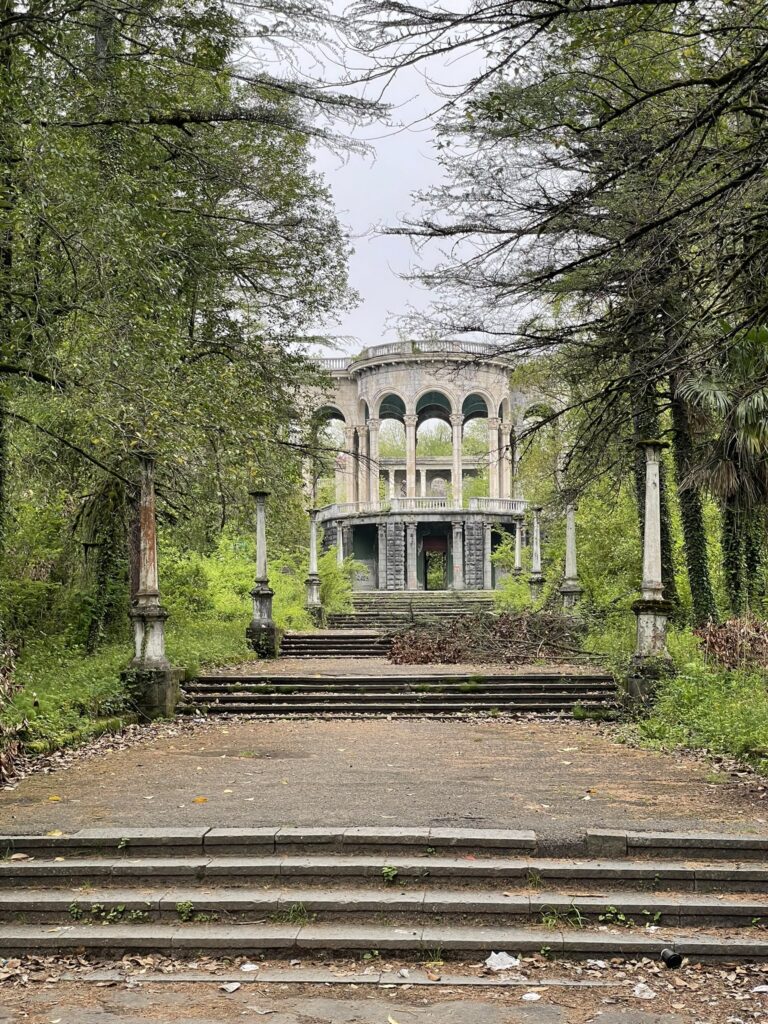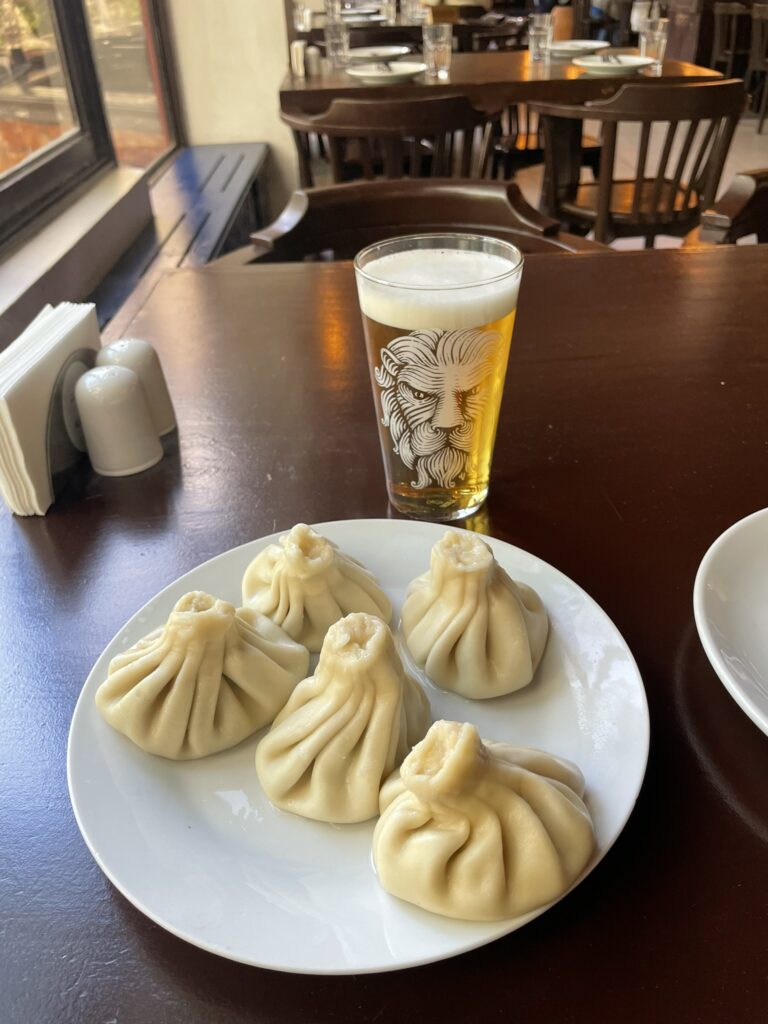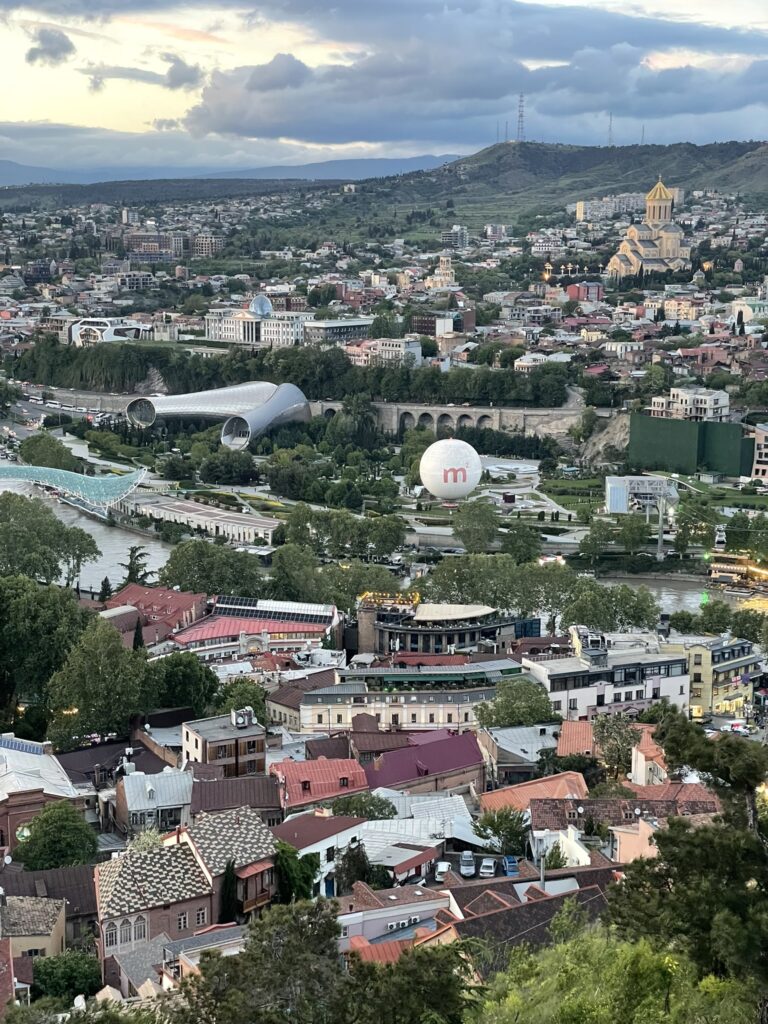We left Kutaisi in the morning. By now, I had substantially recovered from the food poisining, and was feeling good. Our first stop was a town nearby where there used to be 21 sanitoriums in Soviet times. When the Soviet Union collapsed in 1991, the facilities were all closed. Three have been refurbished in recent years and are open, but the rest are now abandoned. Our guide took us to one of the abandoned sites. It was fascinating! You could see how glorious things were (marble steps and floors, painted domes in some of the ceilings etc.), but trees and plants were growing everywhere.

After that stop, we began our trek heading north into the mountains to the Svaneti region. But oh my, the last 60km through the mountain passes to reach the town of Mestia was a drive unlike any other I have experienced! This two-lane road with no shoulders was the most torn up road imaginable. We had to drive very slowly most of the time due to massive potholes or just simply missing parts of the road. We spent half the time in the other lane because our lane was not passable. There were a few spots where our driver was unsure if our vehicle had enough clearance to make it. It was also a bit scary at times. Apparently, this road gets a lot of damage during the winter, but the spring road repairs had not yet started. Almost every vehicle we saw on this road was a high clearance four-wheel drive. It took us 3 hours to go 60km!

That crazy drive was worth seeing one of the most unique places I have ever been. The Svaneti region has its own culture and language. In the town of Mestia where we stayed for two nights, there were numerous medieval stone houses (still being lived in) with watch towers. Our hotel was connected to a tower. It reminded me of the town of San Gimignano in Tuscany, only on steroids.
The next day, a driver in a more specialized vehicle picked us up, and we went further up the mountain to visit the highest inhabited settlement in Europe, the town of Ushguli. The entire town is a UNESCO world heritage site. The tourist season had not really started. Our guide mentioned he had never seen the town with only locals. There were towers, a church from the 9th century, people tending small plots of land with cattle or crops, and a fun little cafe with a few locals. Then it was back to Mestia. After a museum stop, I explored the town a little bit, but it was raining, so I ended up having dinner at the hotel.
The next day was time for the drive back down the mountain. But that day it was raining, so conditions were worse! We encountered one mudslide that had blocked the right lane, with perhaps a foot of mud in the left lane, and no guard rail as you peered down a steep slope. Elevated heart rate time! Thankfully, our driver was very skilled and careful, and got us through okay. Our guide was informed later that day that the mudslide worsened and the road had been closed. Whew! Glad we made it! After we were through the bad part of the road, we stopped to see the Enguri dam, constructed during Soviet times. It is the second tallest arch dam in the world. The hydroelectric station supplies almost half of the power consumed in Georgia.
We were back to Kutaisi for our overnight hotel. In the morning, our guide gave us a tour of the city. At a massive market with local vendors selling fruits, vegetables, meat and everything imaginable, I finally bought what I had been seeing all over Georgia, a churchkhela. This is a candy on a string made with a kind of fruit juice. The one I bought included walnuts.
After the tour of Kutaisi, the rest of the day was simply a drive to Tbilisi. I had one extra day in Tbilisi that was not part of the tour. That worked out well, because I had missed the day of the guided tour of the city. I arrived at my hotel around 2 pm, so I had a day and a half to explore. The hotel was in a great location in the old town, in the area where all the sulphur bathouses are.
The next day was Sunday. I took a local bus to a Catholic church that had an English language Mass. I was glad I arrived early and had a seat. There were more people standing than sitting! I then went to take the cable car up the peak overlooking the city, but, for the second time this trip, a cable car I wanted to ride was not operating due to wind conditions! I had kinkhali and a beer for lunch (no tourists in the place as far as I could tell). I went to the Georgian National Museum. It is right across the street from the Parliament where there were protests about the election late last year. After more exploring of the city in the afternoon, the winds had died down a bit. The cable car was operating! What a bargain it was–a round trip cost 5 Lari (less than $2). The views were spectacular. I stayed up there a while to see sunset, followed by the city lights. For my last dinner in Georgia, I ate at an outdoor cafe in a popular pedestrian zone. I had a Georgian salad, pork shashlik, puri bread and a glass of Georgian red wine (they make their wine in clay pots).


I enjoyed learning about Georgian culture and politics from our guides. I found the relationship with Russia most interesting. Typical Georgians, particularly younger ones, hate Russia. Russia invaded Georgia in 2008 and very quickly took over two regions, South Ossetia and Abkhazia. Those areas had been part of the kingdom of Georgia going back to around AD 200. The average Georgian believes very strongly that those areas are part of Georgia. But Georgia is a small country that cannot stop any aggression from Russia. The balance of trying not to provoke Russia, while maintaining close ties to the West, drives a lot of the complex political and economic situation there.
The tour company, Advantour, did an amazing job (well, perhaps with the exception of the vehicle used to get up the mountain). The value for the money was outstanding. The guides were excellent. Communication before and during the tour was very good. Everything was as advertised. When I became ill, I reached out to the director of the company. He was very responsive. I had several phone calls with him and exchanged many messages. He went over how to access the health care system (if I wanted to see a doctor or get drugs from a pharmacy). He also covered all of the possible scenarios if I needed to delay the tour, and how I could later join the group. After my immediate crisis was over, he still checked in with me regularly about how I was doing. Five stars for Advantour!
At 10:00am on Monday morning, the Advantour driver picked me up at the hotel. I was on my way to the Tbilisi airport for the final leg of my trip. Nakhvamdis Georgia!
Leave a Reply